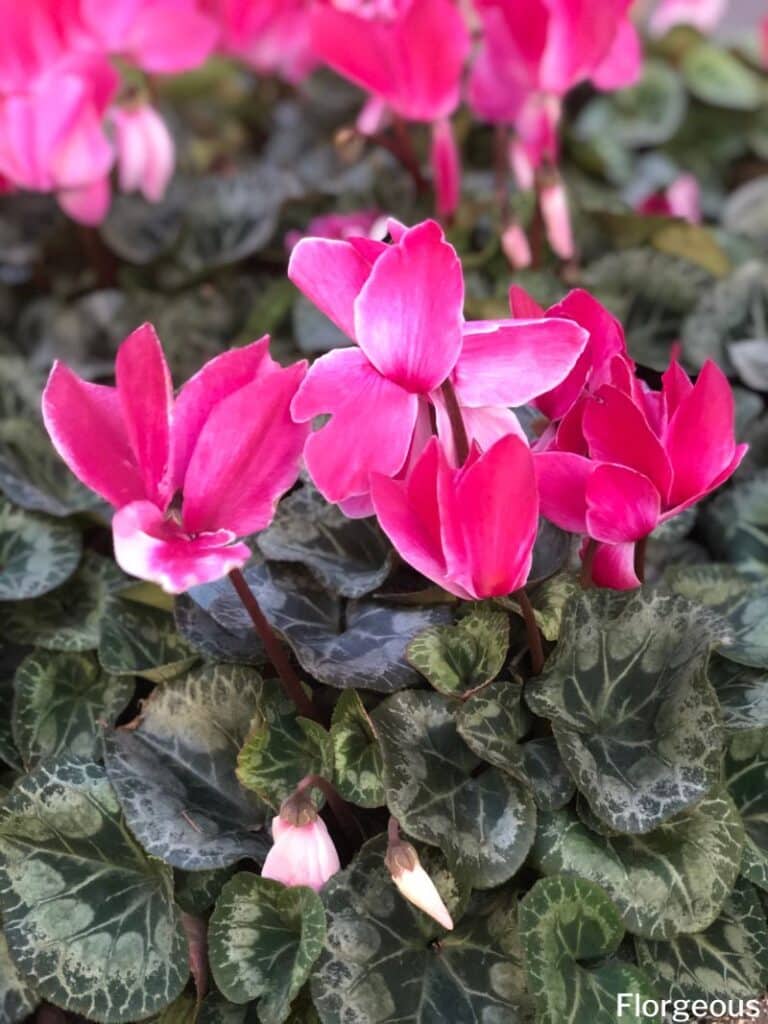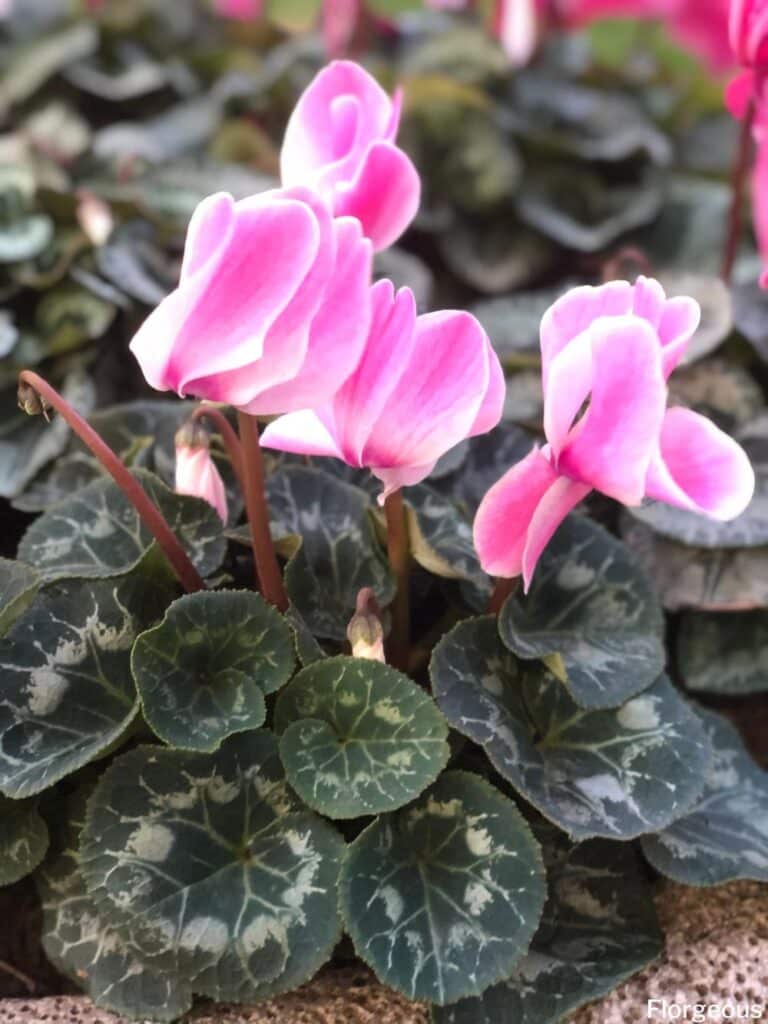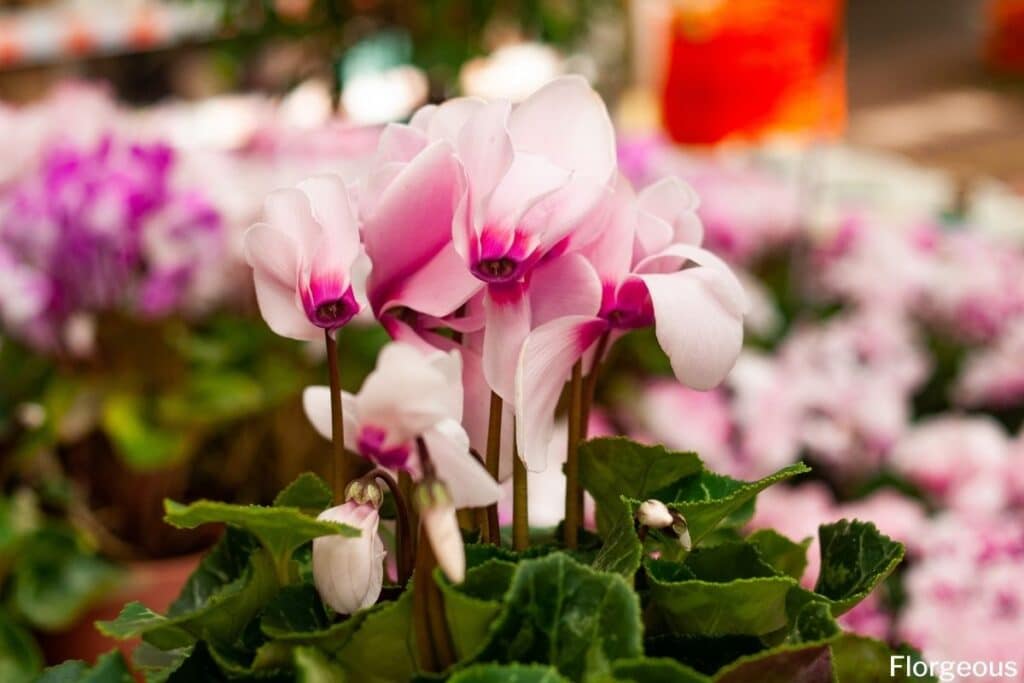Looking for a colorful plant to add to your home during winter? The Cyclamen might be right for you! The Cyclamen is a beautiful houseplant that produces unique, colorful flowers in the winter months. It is native primarily to the Mediterranean region, so it thrives in temperate environments.
This plant is extremely popular and, because of that, many cultivars are bred in places like England, Germany, and the Netherlands to produce a wide range of flower colors and sizes.
Some varieties are more fragrant than others, but all varieties produce a light, sweet scent for your home. Cyclamen plants are perennials, so their dormant season occurs during the summer.
We have compiled an essential guide of what to know about these beautiful plants.
Plant Facts
| Scientific name | Cyclamen persicum |
| Common names | Alpine Violet, Persian Violet, Sowbread, Persian Cyclamen, Florist’s Cyclamen |
| Family | Primulaceae |
| Plant Type | Houseplant, can be moved outdoors in summer for short periods of time with partial light |
| Height and Width | 6-9in tall and wide |
| Origin | Southern Europe, western Asia, North Africa |
| Flower colors | Pure white, lavender, and ranges of pinks, purples, and reds |
| Foliage color | Dark green? |
| Sun Exposure | Indirect light, partial |
| Soil Type & pH | Moist, well-drained, acidic (>5.0) |
| Special features | Not frost-tolerant, great container plants, plant growth occurs primarily during the autumn while flowers bloom late winter into spring, toxic to humans and pets. |
How to Grow Cyclamen
Since Cyclamen are known as houseplants, they grow better and thrive in indoor environments.
Before purchasing your plant, make sure you buy a pot that is at least one inch larger in diameter than the root bulb. This will give the indoor cyclamen plant room to grow properly.
There are many different cultivars to choose from that include different colors and flower shapes. When cyclamen bloom, they produce sweet-scented, small flowers on long stems that stretch up above the foliage. Have fun shopping for cyclamen flowers that stick out to you. Most grocery stores carry them around Thanksgiving to give as gifts, but they are great plants to grow year-round!
Let’s take a look at the factors in growing these beautiful plants.

Propagation
It is important to keep in mind that there are many different varieties of Cyclamen (we will cover them later in this article). Therefore, propagation methods for one may not suit another. When considering propagation for your Cyclamen, make sure to identify the variety you have.
For two of the most common varieties (hardy Cyclamen and florist Cyclamen) the easiest propagation method is through seeds or separating the tuber. A tuber is a swollen underground root from which the plant reproduces. Lift the tuber, divide it from the rest of the plant during the fall season, and carefully plant it under about 2 inches of soil. If you would like, you can lightly cover the soil with mulch to protect the plant during the colder weather.
The other method of propagation is by seed. With this method, the seeds need to be soaked for 24 hours before being planted. When the 24 hours are up, carefully remove the seeds from the water and place them in the soil.
Seed germination takes quite a while, so a mature plant will take a little over a year to be established. It is best to propagate the seeds indoors, but if you would like to plant them outside, it has to be during the summer months.
Soil
These colorful, fun plants prefer well-draining, acidic soil. Regular, houseplant potting mix will do just nicely, but it is recommended that you purchase some peat to mix in with the soil to ensure proper levels of acidity.
The well-draining, acidic soil will promote proper water drainage and keep the plant rich in nutrients. Well-draining soil is especially important since the plant regenerates from tubers.

Pruning
Like most other indoor house plants, pruning must occur when yellowing or dead leaves or flowers occur. To maintain the health of the Cyclamen, locate any dead or dying leaves and sharply twist off the stem to ensure a clean separation.
For dead or dying stems, make sure to use clean and sharp shears to cut near the base.
It is best to prune during the summer months as the warmer temperatures allow the plant to heal nicely. If you prune during the winter, make sure to place the plant within warmer parts of your house to encourage regrowth.
Repotting & Transplanting
When repotting, it is always essential to remember to buy a pot that is at least one inch larger in diameter than the size of the root ball or, in this case, the tuber. This will give the plant enough room to grow.
Before placing the Cyclamen houseplants in the soil, fill the pot halfway with potting mix. Then, you can gently lift the Cyclamen out of its previous pot, dust off the old soil, and place it in the soil so part of the top of the tuber is sticking out. Finally, you can fill the rest of the pot with soil until it reaches just under the rim of the pot.
After you’ve successfully repotted the Cyclamen, you don’t have to repot or transplant it again for about two years. Make sure that the plant is in a relatively dry location and water starting in September if you’ve repotted during the summer (the plant’s dormant season).

How to Care for Cyclamen
Cyclamen plants are picky when it comes to administering care. But don’t worry, we have the cyclamen care indoors and outdoors guide you need to take proper care of this beautiful, lush plant.
Water
In terms of watering, it is important to frequently monitor the dryness of the soil. You don’t want the soil to be completely dried out and you don’t want it to be too moist before watering.
A good way to decide when it’s time to water is to stick your finger about an inch into the soil. If the soil is dry, then you can give the plant some water.
When watering, make sure to thoroughly water the soil without getting a ton of moisture on the leaves. Accidentally watering the leaves too much can lead to root rot.
Sunlight
When the Cyclamen is actively growing, it is best to keep the plant in bright, indirect sun so it is important to choose cyclamen companion plants that can also thrive in similar low light conditions.
When it comes to cyclamen light requirements, choose a well-lit area in your house that receives natural light for a good amount of the day.
During the summer months when the plant is dormant, you can move it to a darker, cooler place in your home so it can properly rest and store up energy for the colder months.
Temperature & Humidity
Cyclamen plant does not tolerate heat or dry temperatures all that well. Considering its origins, it is best that they are grown and cared for in temperate environments ranging from 40-70 degrees Fahrenheit.
When growing cyclamen indoors, keep them away from direct sunlight. At night, these potted plants prefer the warmer side of the temperature range due to the lack of sunlight.
Cyclamen plants also thrive in high humidity. During the winter, it is best to set the pot in a tray filled with water and pebbles. Make sure that the pot isn’t constantly touching the water or it will cause root rot.

Fertilizer
Cyclamen does need a good fertilizer in order to be healthy, lush, mature plants. The key to a good fertilizer for these plants is nitrogen.
For Cyclamen, make sure that the fertilizer has low levels of nitrogen and is administered every couple of weeks during its blooming season. During the summer months, you do not need to fertilize the Cyclamen.
Pests & Diseases
There are a few pests and diseases to look out for. Here are a few to look out for and some tips on how to get rid of them.
Mites
Mites typically congregate in between the stems and leaves. If you begin seeing stripped, yellow leaves, the Cyclamen may have mites. In order to get rid of them, the best method is to use insecticidal soaps or oils. Repeat the treatment until the mites are gone.
Aphids
Aphids are incredibly small bugs that are usually green or black in color and stay around a plant’s roots or leaves. They suck out the nutritious sap in a plant which usually results in a stunted plant with curling leaves.
You can purchase ladybugs to eat and chase away the aphids or spray the plant with insecticidal soap.
Root Rot
Root rot is typically caused by overwatering your plants. Make sure to look out for cyclamen yellowing leaves and only water your plant when an inch of the soil is dry. Similarly, overwatering can cause a fungus (botrytis) to grow resulting in yellowing or browning leaves.
Common Varieties & Cultivars
There are three common Cyclamen varieties.
The ‘Sierra’ series has very large flowers that range in colors from lavender, salmon, and pink.
‘Victoria’ has white flowers with red accents.
‘Scentsation’ varieties have very fragrant flowers that come in ranges of red and pink.
Many are bred in England, Germany, and the Netherlands to increase flower size, expand color options, and diversify the pedals. For example, certain cultivars can have tiny flowers or flower buds that range from two to three inches across.
Cyclamen toxicity
It’s important to be aware that cyclamen plants contain certain compounds that can be toxic to cats and dogs.
When cats or dogs consume cyclamen, they may experience symptoms such as drooling, vomiting, diarrhea, abdominal pain, and, in severe cases, even heart irregularities. It’s important to note that the severity of the symptoms can vary depending on the size of the pet and the amount ingested.
If you suspect your pet has ingested any part of a cyclamen plant or is showing signs of toxicity, it’s crucial to seek veterinary attention immediately.
FAQs
Does cyclamen like sun or shade?
Yes, Cyclamen plants prefer bright indirect light, so they thrive in partial shade or filtered sunlight. Direct sunlight can be too harsh for cyclamen leaves and may cause them to scorch or wilt.
Are cyclamen indoor or outdoor plants?
Cyclamen are commonly grown as indoor plants, although they can also be grown outdoors in mild climates. Indoors, they can be placed near a window where they can receive bright, indirect light.
How often do you water a cyclamen plant?
Cyclamen plants prefer to be kept evenly moist but not waterlogged. Water them thoroughly when the top inch of soil feels dry to the touch, allowing any excess water to drain away. Avoid overwatering, as this can lead to root rot.
How long does a potted cyclamen last?
With proper care, a potted cyclamen can last for several weeks to a few months, depending on the variety and growing conditions. They are often sold as temporary flowering plants and may enter dormancy after flowering. With proper care, they can be encouraged to bloom again in subsequent seasons.
Conclusion
If you are looking for a colorful addition to your houseplants, Cyclamen might be right for you. Their bushy foliage and beautiful flowers are perfect for any home. If you live in an extremely hot or cold environment, it is important to control the temperature and humidity of your home for the health of this plant.
Although these plants thrive indoors, you are able to place them outside during their dormant season (summer) if you would like. Make sure to check out the diverse cultivars to pick out the color and flower size you want.
Talk to a gardening expert to obtain more information about pruning and germinating seeds. Happy planting!
Don’t forget to check our guide on cyclamen flower meaning and symbolism to learn more about this plant.







